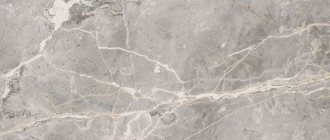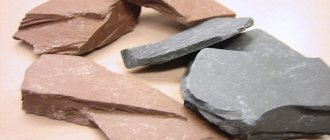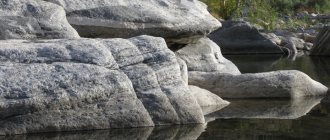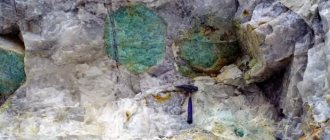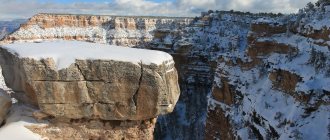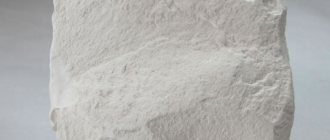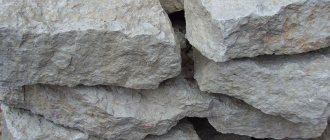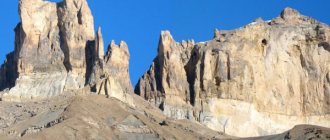4.5
Average rating: 4.5
Total ratings received: 18.
4.5
Average rating: 4.5
Total ratings received: 18.
On the streets of southern cities you can often see houses made of light stone with mollusk shells. In the subway, wall cladding with slabs with different types of sinks attracts the attention of passengers. In the rubble, on the river beach, in the old quarry, you can also find fragments with fancy shells. What is the name of this rock, where is it formed, and how is it used, we will consider in the article.
What is limestone
Limestone is a sedimentary rock, during the formation of which a porous stone of varying density and shade is formed with an abundance of calcite (lime spar). The structure of the material also includes other minerals that reduce its porosity and increase its strength. Limestones are deposited mainly in salty sea basins, less often - during the evaporation of lagoons and lakes. The color of limestones is predominantly light gray, beige, and yellowish. The presence of organic, ferrous, manganese and other impurities causes dark gray, brown, reddish and greenish coloring.
As a rule, the origin of limestone is associated with the vital activity of organisms that secrete calcium carbonate from salt water to form skeletons and shells. Less commonly, the material is of chemogenic origin. Subsidence of rock lasts millions of years (modern strata remained after the drying of ancient seas). The thickness of the limestone deposits is radically different: from a few centimeters to five kilometers. The younger the deposits are, the looser the rocks are.
Varieties
There are many types of limestone. Shell rock is usually called an accumulation of shells and their fragments cemented into a cellular rock. In the case when the shells are very small in size, soft, loosely bound, smearing, finely crumbling limestone—chalk—is formed. Oolitic rock consists of miniature, fish egg-sized, cemented balls. The core of each of them can be represented by a fragment of a shell, a grain of sand, or any other particle of foreign material. In the case when the balls are larger in size, for example, the size of a pea, they are usually called pisolites, and the rock, accordingly, is called pisolite limestone. The next variety is travertine - it is formed on the surface during the precipitation of aragonite or calcite from the waters of carbon dioxide sources. If such deposits have a highly porous (spongy) base, it is called tuff. An unconsolidated mixture of clay and calcium carbonate is called marl.
In addition, limestones may differ in color. The main color is white. But it can also be yellowish, light beige, light gray, or less often slightly pinkish. The white-pink and white-yellow breeds are considered the most valuable.
Types of limestones
According to its structure, the stone is divided into the following types:
- Crystalline is a dense mineral, similar in structure to marble. It polishes well due to its small pores and is frost-resistant.
- Organogenic-clastic is a well-known shell rock, consisting of the remains of marine organisms. It is well processed (sawed, trimmed), has high porosity. This type also includes reef limestone, extremely rich in the remains of marine fauna, and ordinary chalk, a weakly cemented carbonate rock (in fact, hardened silt of warm seas).
- Clastic-crystalline - organogenic detritus formed from fragments of plants, shells and animal skeletons. Despite the small pores, it has low strength and a high degree of water absorption.
- Sinter (calcareous tuff) - is formed in standing and flowing underground reservoirs from insoluble salt, which compacts under pressure. Stone from standing water bodies is denser, while stone from flowing water bodies is porous and fragile.
By origin, the stone is divided into:
- Biogenic is deposits of carbonate remains of marine organisms with a small proportion of carbonate cement.
- Chemogenic - formed in salt water or underground springs (the same tuff) by the precipitation of lime.
- Clastic - formed from angular-rounded fragments of limestone rocks during their fragmentation and washout.
- Mixed - a consequence of the simultaneous occurrence of several processes during which carbonate materials are formed.
Under the influence of high temperatures and pressures, limestone gradually compacts and becomes harder, and its grain size decreases. The result is marble - essentially metamorphosed limestone with a dense crystalline structure. There is no sharp phase transition; marble is formed gradually, so intermediate options are found in nature (for example, marbled limestone, which is both dense and easy to cut).
Origin story
The origin of limestone rocks began hundreds of millions of years ago. Since primitive times, people have built their homes in grottoes and caves made of limestone. Since then, stone began to be used as a unique, durable building material, from which the cities of Ancient Rus', statues, sculptures and monuments were subsequently built.
Cultural masterpieces created from limestone many centuries ago and preserved to this day include the Egyptian pyramids, the Chinese Wall and the Kremlin in Moscow.
Properties of limestone
The properties of the stone vary depending on the source of origin and directly depend on the structure of the material. Even within the same deposit, there may be deposits with different densities, volumetric mass and strength. Denser crystalline rocks are well polished, porous ones (for example, shell rock) are easy to saw and trim.
Physical characteristics of the material:
- Density – 2700-2900 kg/m³.
- Volumetric mass – from 800 kg/m³ (shell rock) to 2800 kg/m³ (marbled rocks).
- Hardness on the Mohs scale – 3.
- Compressive strength ranges from 0.4 MPa (shell rock) to 300 MPa (crystalline).
The basis of limestone is calcium carbonate (50-95%). The rest is quartz, dolomite, feldspar and other minerals (5-50%). It is due to the presence of minerals in the composition that the stone has different shades. The color of limestone is predominantly white, but in nature there are abundant rocks of light gray, light yellow, reddish, green, and brown shades. There is even black limestone - it contains an abundance of petroleum products. In general, the stone is known for soft, pastel tones and unobtrusive color combinations.
Physically and chemically, limestone is not very stable. It dissolves in water (albeit slowly), so when using stone in finishing work, it is treated with water-repellent compounds. The mineral is especially vulnerable to the effects of acids (in particular, acetic, sulfuric, hydrochloric), and the reaction proceeds violently and quickly, with the formation of carbon dioxide. Under natural conditions, this is fraught with the formation of karst voids, often of impressive size. The frost resistance of stone varies significantly depending on porosity and the presence of cracks. Marbled rocks with a dense crystalline structure have the greatest frost resistance (up to 400 cycles).
Chemical industry
Even things like shoe polish, toothpaste, cleaning powder, etc., which we use every day, are derived from limestone. These raw materials are also used in the manufacture of products used to protect the environment from various types of pollution. Based on all of the above, we can safely say that the widely known and accessible material, which is limestone, represents the most important element of modern civilization.
The peoples of South and Central America made a great contribution to the development of stone carving. The Olmecs, Aztecs, and Mayans achieved significant success in the ability to make weapons, cutting tools and other household items from chalcedony, obsidian and silicon. Thus, they created rolling pins, grain grinders, mortars, etc. from basalt, sandstones and limestones. Percussion and chopping tools were made from diorite, jadeite, jade and other materials. The main centers for stone processing are the Mayan cities of Tonina and Nebah.
), consisting of small fragments and entire calcareous skeletons of microorganisms (coccoliths, foraminifera ( see.
FORAMINIFERS), etc.). Used in cement, glass, rubber and other industries.
Encyclopedic Dictionary . 2009.
See what “CHALK (limestone)” is in other dictionaries:
- LIMESTONE, sedimentary rocks formed at the bottom of a warm sea from the remains of living creatures that lived in the water. At least 50% of limestone consists of calcite (CaCO3). There are many different types: Carboniferous limestone, CHALKET, oolitic and... ... Scientific and Technical Encyclopedic Dictionary
Abbr. name Cretaceous system and period. Geological Dictionary: in 2 volumes. M.: Nedra. Edited by K. N. Paffengoltz et al. 1978. Chalk ... Geological Encyclopedia
A (y), prev. about chalk, in chalk; m. 1. Soft white limestone. Chalk mining. // A piece of this limestone; powder or solution used for writing, whitewashing, cleaning, etc. Dissolve the m. Whitewash the ceiling with chalk. Write on the board with chalk. The entire sleeve is in ... Encyclopedic Dictionary
Calcilutite, zoolite, madreporite, shell rock, chalk, phytolite Dictionary of Russian synonyms. limestone noun, number of synonyms: 16 anthraconine (2) ... Dictionary of synonyms
Sanguine, chalk, limestone Dictionary of Russian synonyms. chalk noun, number of synonyms: 6 limestone (16) ... Dictionary of synonyms
Dahl's Explanatory Dictionary
CHALK, (stranded?) male, bonfire, Perm. yeast, yeast. II. MEL husband soft, powdery limestone; aqueous lime carbonate, white paint. | north and east yeast, yeast (or chalk?), in yarosl. stranded noun | Chalk, in birds of prey, disease, hard white... ... Dahl's Explanatory Dictionary
Limestone
- - sedimentary rock, chemical composition - calcium carbonate CaCo3; used as a facing material (for example, in plinths), for the manufacture of cornice slabs, blocks for stands, intermediate blocks in column trunks, ... ... Encyclopedia of terms, definitions and explanations of building materials
See Limestones. Geological Dictionary: in 2 volumes. M.: Nedra. Edited by K. N. Paffengoltz et al. 1978. Limestone ... Geological Encyclopedia
CHALK, a (y), about chalk, in chalk, husband. Soft white limestone, used. in industry, for painting, writing. Write with chalk on a blackboard. White as m. | adj. chalky, oh, oh. Chalk mountains. Ozhegov's explanatory dictionary. S.I. Ozhegov, N.Yu. Shvedova. 1949 1992 ... Ozhegov's Explanatory Dictionary
Data-lazy-type=”image” data-src=”https://karatto.ru/wp-content/uploads/2017/12/izvestnyak-1.jpg” alt=”white limestone” width=”350″ height =»204″> Everyone is familiar with limestone: both pliable chalk and durable marble are essentially it. The mineral is unprepossessing in appearance, not rare in nature, and not difficult to process. And with all this, he managed to become famous in culture and history: ancient Egyptian pyramids, majestic temples and cathedrals, the famous Wall of China, the Moscow Kremlin and other masterpiece buildings were created from it. There are many signs associated with it; truly miraculous properties are attributed to it. The origin of natural limestone, its varieties, and various uses will be discussed further.
Limestone mining
In Russia, the mineral is mined and developed primarily through drilling and blasting (D&B). Stripping work is carried out in advance - the top layer of soil is removed using a bulldozer and subsequently used for reclamation. Shafts up to 24 meters deep are drilled into a solid layer of limestone, and industrial explosive materials and detonators (TNT blocks) are placed in them. One explosion usually requires 2-3 dozen wells and about 5 tons of explosives. The wells do not explode simultaneously, but with a delay of a fraction of a second.
There is an alternative European technology for limestone mining called Rip&Load (loosening and loading), which allows you to work without the use of drilling and blasting equipment. The face mass is destroyed using a special ripper on a heavy excavator, after which the operator, without leaving the cab, changes the ripper to a bucket and loads the destroyed rock mass into a dump truck. Then the operation is repeated. The advantage of this technology is the selective excavation of limestone in deposits with a layered structure. In both cases, heavy industrial equipment is used. For example, the operating weight of excavators in quarries can reach 240 tons, and their productivity can be 800 t/h.
The resulting rock fragments are loaded by a heavy excavator into mining dump trucks and transported to the crushing and processing plant (COP). As a result, the quarry bowl moves towards the calcareous rocks, and the mined-out space is gradually filled with screenings and overburden.
At the crushing and processing plant, limestone is successively subjected to coarse, medium and fine crushing. Small particles of stone (up to 1 cm) are transported back to the quarry. The finished product (crushed stone) is loaded into railway cars or vehicles and sent to consumers. In places with small deposits, limestone is simply sawed into rectangles of the required size and transported by truck to the plant.
In Russia, the main deposits of the mineral are located in the Moscow and Tula regions. In Tula (in addition to the usual) valuable marbled limestone is mined, in the Moscow region - a rare cream-colored rock. Limestone is found in almost every region of the Earth, and some quarries have been in use for thousands of years.
Popular message topics
- What is a Review?
A review is a critical review or expert opinion. The main thing in this review or conclusion is professional criticism and analysis of any work or any work in the scientific field. It could be anything - Russian sacred music
Singing in church was the only manifestation of musical art in Russia, from the advent of Christianity until the 17th century. A lot of things were taken from Byzantium. Church singing was a secretive activity in Russia, but some sources of information - Eagles
Eagles are representatives of large birds belonging to the hawk family. Their species diversity comes down to 17. Each has its own distinctive characteristics, occupying a place of honor in the classification of birds.
Use of limestone
Limestone is a universal material that has found application in manufacturing, agriculture, construction, and interior design. The scope of use of the stone varies depending on its origin, physical characteristics, and composition. The main areas of use of limestone:
- Construction. Some types of limestone are strong enough to be used for low-rise buildings, but in most cases the material is used as cladding. It is used to make wall panels, facing slabs, and decorative elements - columns, pilasters, bas-reliefs. Small fractions of stone are used as crushed stone in the production of concrete, while large fractions are used for arranging the foundations of highways and hydraulic structures. Rubble stone (large fragments up to 500 mm in size) is suitable for foundation work.
- Finishing and cladding. Limestone is a popular façade material that withstands Russian climatic conditions well. Thin sections of wear-resistant stone are a ready-made material for laying garden paths and sidewalks.
- Interior design. Marbled limestone of rare shades is used for finishing walls, stairs, floors, making kitchen countertops, window sills, and bar counters. The stone of exquisite colors is suitable for creating fireplace portals, coffee tables, and decorative columns. Among designers, layered stone with a pronounced relief is especially valued.
- Production of finishing materials. Whitewash, paint, and putty are made from limestone.
- Production of cement. Carbonate components in the raw material mixture for cement production can reach 80% of the total volume of raw materials. Along with limestone, clay, slag, and corrective additives are added to cement.
- Chemical industry. The material is used in technologies for the production of plastic, rubber, and pharmaceuticals.
- Production of sugar, glass, soda. Here the mineral is used as an additional raw material. For example, in the production of sugar, lime is used, obtained by burning carbonate rocks.
- Metallurgy. Limestone is an indispensable component in metal smelting. Limestone flux lowers the melting point and makes it easier to separate the metal from the gangue. Used with ores rich in silica and alumina.
In addition, limestone is actively used as a component of toothpastes and shoe creams, in the production of filters and mineral fertilizers. The mineral is also used in paper production - about 800 kg of finished products can be obtained from one ton of material. Some types of limestone are used in the production of abrasives for fine grinding, and in agriculture it is used as a mineral additive for livestock and poultry.
Limestone is important not only for finishing buildings and interiors. It is indispensable in the creation of cement, and is also used in other industries, such as sugar refining and glass production. When limestone is heated, it is used in the production of iron and steel, as well as alumina and magnesia. Limestone also helps purify drinking water. Farmers often use fertilizer that contains crushed limestone on crops. Limestone in the mixture is a source of nutrients and neutralizes soil acidity. Powdered limestone is used to remove impurities from cast metals. Limestone is used as a filler in a variety of products, including paper, plastics and paint. The purest limestone is even used in foods and medicines such as calcium tablets and breakfast cereals.
Magic of stone
The magical effect of limestone is similar to that of calcite. It also develops intuition in people, the ability to foresee actions and consequences. With its energy, the stone attracts the attention of others to its owner on an emotional level. This property is often used by girls to attract a guy they like.
A talisman with limestone will protect you from wrong decisions and protect you from troubles. The stone helps get rid of laziness and bad mood. In creative natures, he will develop imagination and a thirst for beauty.
Back to contents
Limestone in architecture and design
Limestone is a very popular material for construction and cladding of buildings. Suitable for cladding facades, as well as for creating decorative elements of the exterior - bas-reliefs, columns and pilasters, brackets. The scope of interior design solutions is quite wide: the manufacture of columns, arches, fireplace portals, limestone finishing of floors and walls, door and window openings. Some types of limestone are suitable for rooms with high humidity (bathrooms, swimming pools).
In landscape design, limestone is used in the design of paths, terraces, decorative walls, fences and the construction of alpine slides (retains heat, allows water and air to pass through, normalizes soil composition).
In our country, domestic limestones, Spanish limestones and German marbled limestones are popular. Due to its relatively low price (compared to other natural stones) and resistance to temperature changes (the number of winter/summer cycles), limestone is the most popular material for finishing the facades of residential complexes and commercial buildings and structures.
The most popular limestones:
Jura Beige
Jura Gray
Jura Rahmweis
Branco Valongo
Branco do Mar
Place of Birth
Some mountain ranges are entirely composed of this mineral. The breed is widespread in the Alps and Crimea. Of the continents, North America is also rich in stone, but Australia is lagging behind in this sense: its constituent rocks do not contain calcite. The most fertile deposits are concentrated in the Caucasus, the Siberian region, and the Urals. China is an important supplier of a type of construction mineral – marl. The Zhdanovskoye deposit, which was developed on the territory of the Russian Federation in the Orenburg region, is recognized as a very promising modern source of limestone.
Photos of limestone
Below you can see some photos of limestone in various uses. Facades, wall decoration, paving, etc.
Comparison
The areas of application of chalk and lime (it would be more correct to say lime, since there are several of them) differ quite greatly. We all know student chalk, which is widely used in school, but this is only one of its “specialties”. In addition, it has found application in the production of high-quality coated paper, as well as in the creation of certain types of rubber and in the food industry. Chalk often plays the role of a filler in various compositions - from paint and varnish products to polymers (polypropylene and polyethylene). And, finally, what makes it similar to slaked lime is that both of these materials are suitable for whitewashing tree trunks, borders, fences, and so on.
Different types of lime differ quite greatly, so their areas of application are also far from each other. Quicklime is used in construction and to produce other types of limes. Slaked lime, in addition to whitewashing, is needed in the production of building materials, lime agricultural fertilizers, and leather tanning. In dentistry - for disinfection of the dental canal, and in electrical engineering - as a composition that allows reducing (where necessary) soil resistance when installing grounding. And finally, even in the food industry, slaked lime is known as food additive E 526.
The two main “specialties” of bleach are disinfection and bleaching of fabrics. If she copes with the first perfectly, then in the second case you need to be careful and use only industrially prepared compounds, since with a high concentration of the composition it will simply “eat through” any fabric. And the main “vocation” of soda lime is the absorption of carbon dioxide from the air. This property is indispensable in gas masks and diving equipment. It was even used for a similar purpose in the first spacecraft, but later they switched to more effective formulations.
Leave your comment
Rosobrnadzor spoke about the preliminary results of the Unified State Exam 2021
Reading time: 3 minutes
Hungary bans LGBT propaganda in schools
Reading time: 1 minute
Ural student had his diploma grade reduced for having colored hair
Reading time: 1 minute
The Rostov school enrolled 19 first classes
Reading time: 1 minute
Moscow authorities announced mandatory vaccination of education workers
Reading time: 2 minutes
The decision to admit unvaccinated students to classes remains with universities
Reading time: 1 minute
Gift certificates
Responsibility for resolving any controversial issues regarding the materials themselves and their contents is taken by the users who posted the material on the site. However, the site administration is ready to provide all possible support in resolving any issues related to the work and content of the site. If you notice that materials are being used illegally on this site, please notify the site administration using the feedback form.
All materials posted on the site were created by the authors of the site or posted by users of the site and are presented on the site for informational purposes only. Copyrights for materials belong to their legal authors. Partial or complete copying of site materials without written permission from the site administration is prohibited! The opinion of the administration may not coincide with the point of view of the authors.
Source
